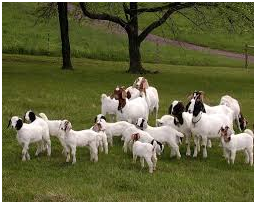Small Ruminant Laparoscopic Artificial Insemination
What it is:
• Minimally invasive surgical procedure to breed does/ewes to superior bucks/rams using frozen semen
Key Benefits:
• Enhance genetic quality in your herd/flock
• Eliminate expense and danger of keeping potentially aggressive bucks/rams
How does it work?
• Prior to breeding we will work with client to synchronize animals to show estrus at the same time using naturally produced hormones. These can be administered by the owner or by us. On breeding day, we travel to client’s farm with all supplies needed or they can come to us. The animals are sedated, placed in the cradle, clipped, prepped, three small incisions (<1in) are made, the female is bred, the incisions are closed with skin staples, the animal is moved to a recovery area and can be reversed. • Semen can be shipped to and stored at our office if needed. • We can also offer advice on nutrition for the females to enhance ovulation and increase number of progeny. • We offer fetal ultrasound to confirm pregnancy. Laparoscopic Artificial Insemination and Embryo Transfer in Sheep, Deer and Goats These are new and exciting additions to the practice. Using laproscopic AI, in conjunction with estrus syncronization, it is possible to obtain good pregnancy rates without having a ram/buck on the premise. Breeding can be done at a convenient, scheduled time using CIDR’s and a modified Ov-Sync protocol. The AI procedure takes 5 – 10 minutes, once the equipment is set up. The best genetics can be obtained and stored until needed. I have plenty of storage for semen in my tanks. With prior arrangement, semen can be shipped to VHHMS and stored for scheduled procedures. Embryo collections are surgical and take approximately 15 – 20 minutes for collection and an additional an hour or so for searching the dish and grading. Fresh embryos can be placed and/or the remainder cryopreserved. Embryos are frozen for direct thaw for easy implantation (unless otherwise desired). Once frozen, the embryos are good indefinitely. Freezing will decrease potential pregnancy rates ~10% from fresh embryos on average. We also offer ultrasound for small ruminants. I am American Embryo Transfer Association certified to collect and freeze embryos. I can also USDA qualify to inspect and export embryos to the EU and many other countries. I freeze the embryos Direct thaw for easy implantation (unless otherwise desired).
The Process
It starts with a 7 day CIDR protocol(modified Ov-Sync) Shown is a CIDR and a PRID
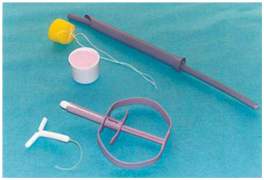
Folltropin-V is a natural FSH product, used for super ovulation
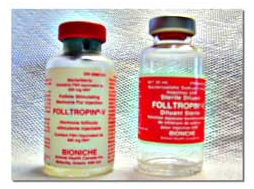
A straw of semen Straws are either 1/2 cc or 1/4 cc. Fertility or number of spermatozoa are not affected by straw volume. I prefer 1/4 cc straws but they all handle the same way.
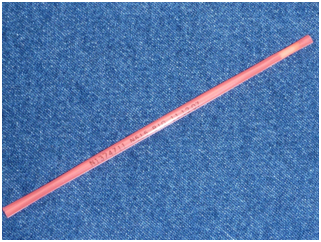
The Laparoscopic instruments:
Laparoscope with light onA Laparoscope is sort of like a rifle scope. It provides magnification and lighting
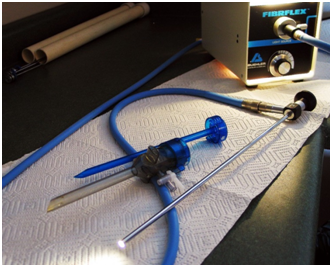
More toys – the cradle for placing the doe in
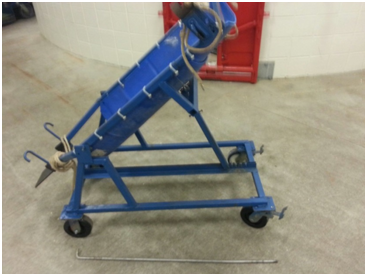
Placing trocars in abdomen and inflating the abdomen so
that the uterus can be visualized
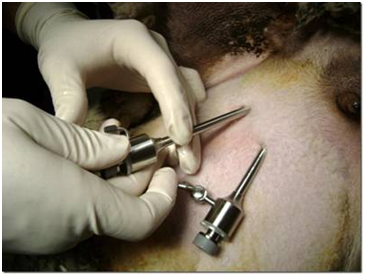
Positioning the AI rod (Photo from Drost Project)
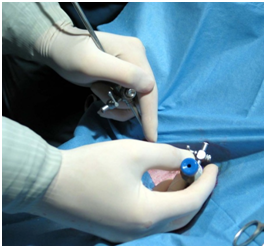
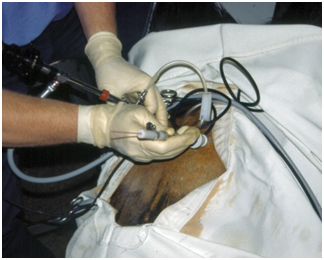
A good laparoscopic image of turgid uterine horns from a ewe in estrus (turgid due to estradiol release (from follicle), oxytocin release (pituitary and ovarian) and prostaglandin release (endometrium))
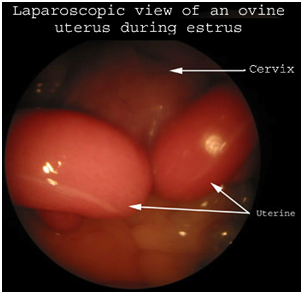
Schematic of what is being done
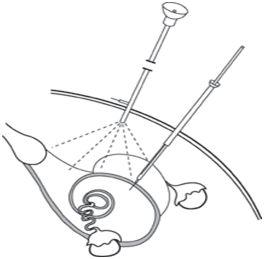
Laparoscopic view of puncturing the uterine wall and semen deposition.After this the trocars are pulled and the abdominal incisions are closed with staples.
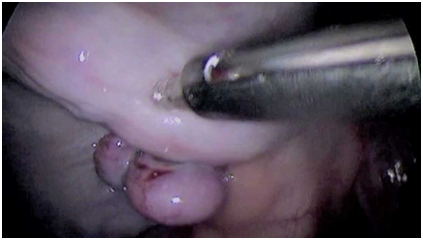
Goat Oocytes (unfertilized eggs) as viewed from a microscope.Hopefully the female is going to ovulate these ova in @ 12 hours post breeding.
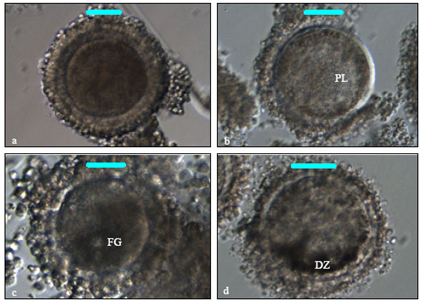
Then the spermatozoa find and bind with the oocyte. Hopefully 1 spermatozoa penetrates the zona pellucida.If this happens, then in 6 days or so we get this below…
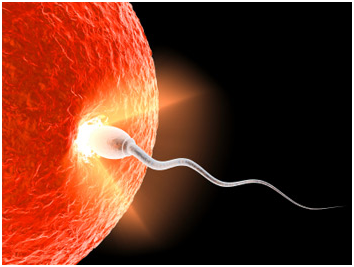
Embryo – Morulae (stage 4 #1) as seen through a microscope – this is a nice embryo. I would expect to find it @ day 6 post breeding
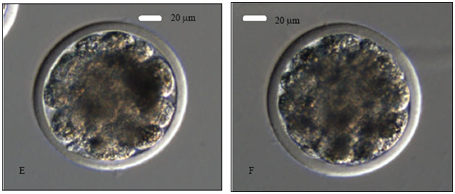
A nice collection of embryos as seen through a microscope. These are later maturity – say day 7 to 8 post breeding. Several are collapsed blasts which means that they are ready to hatch out of the zona pellucida which surronds the cell mass (See bottom left, upper right third down and the one to its left.)
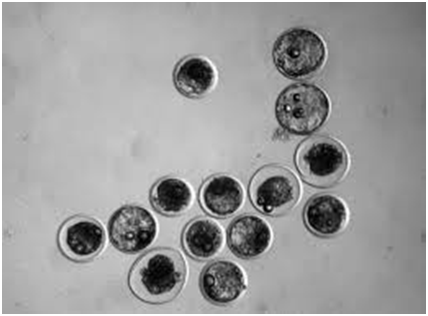
Embryo collection. Notice the rubber catheter in the left horn (goat is upside down). The catheter goes to the collection dish.
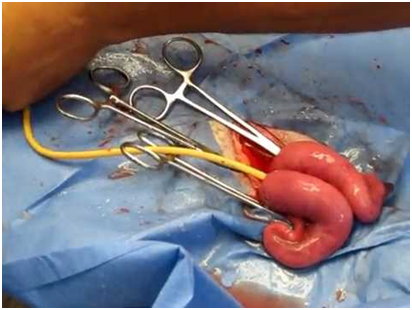
Another image of embryo collection. The syringe is injecting collection media into the uterotubal junction of the uterus. This is pushing embryos in the uterus caudal to the catheter which is draining into the dish.
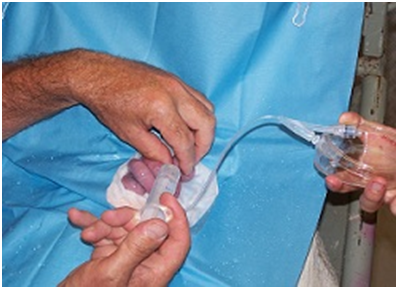
Implanting (fresh embryos or frozen) is done on a female 6 – 8 days post estrus. The embryos can be placed laparoscopicallyusing the same equipment as for AI
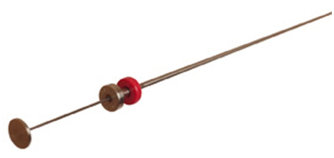
Ultrasound image of a 38 day fetus.Then add 3 months and we get the ewe below…
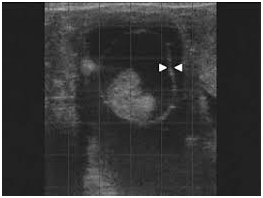
Late stage ewe
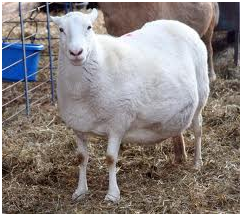
Parturition (birth)
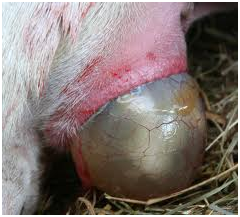
And finally this is the goal
